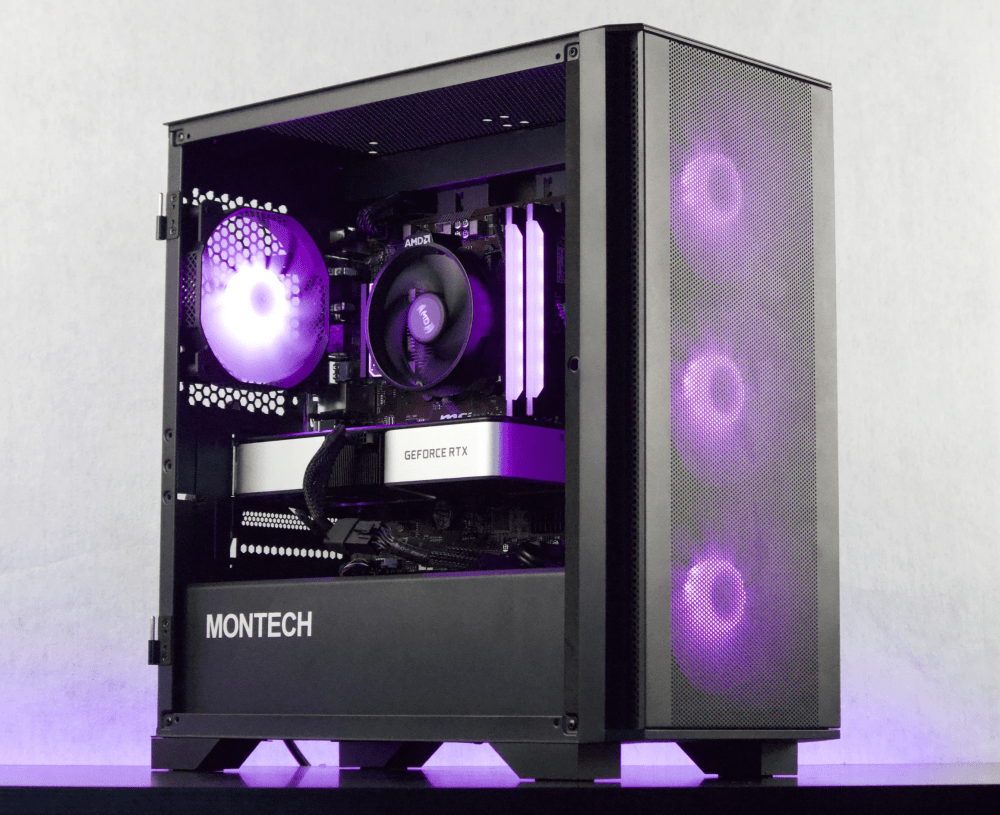Welcome to our blog post on how to underclock a GPU! If you're a tech enthusiast or a gamer, you're probably familiar with the concept of overclocking – the process of increasing the clock speeds of your GPU for enhanced performance. However, did you know that you can also underclock your GPU?
Underclocking involves reducing the clock speeds of your graphics card, which may seem counterintuitive at first. But there are several scenarios where underclocking can be a useful technique to optimize your GPU's performance and address certain issues.
In this blog post, we will delve into the basics of underclocking a GPU, including the reasons why it might be necessary, the potential risks and benefits associated with underclocking, and the tools required to undertake this process. We will also guide you through the step-by-step process of safely underclocking your GPU, as well as provide tips on maintaining your underclocked GPU for optimal performance.
Before we dive into the process of underclocking, it's essential to understand why and when you might need to underclock your GPU. We'll explore the various scenarios where underclocking can be beneficial, such as reducing power consumption, managing heat generation, and addressing stability issues.
Underclocking your GPU comes with its own set of risks and benefits. We'll discuss the potential risks involved in underclocking, such as reduced performance and compatibility issues, as well as the benefits, including improved power efficiency and cooler temperatures.
To underclock your GPU effectively, you'll need the right software and hardware tools. We'll guide you through the process of selecting the appropriate software for underclocking, understanding the software interface, and ensuring your hardware meets the requirements for underclocking.
Once you have the necessary tools in place, we'll walk you through the step-by-step process of safely underclocking your GPU. We'll explain how to lower clock speeds, test for stability, and make adjustments to voltage settings to ensure optimal performance.
After successfully underclocking your GPU, it's crucial to maintain it for long-term stability. We'll provide tips on monitoring GPU temperatures, determining when to return to normal clock speeds, and best practices for ongoing maintenance.
Whether you're looking to optimize power consumption, manage heat generation, or address stability issues, underclocking your GPU can be a valuable technique. Stay tuned for the upcoming sections, where we'll explore each aspect of underclocking in detail, helping you master this process and unlock the full potential of your graphics card.
Understanding the Basics: Why and When to Underclock a GPU
Underclocking a GPU may seem like a counterintuitive concept, as most users are accustomed to maximizing performance through overclocking. However, there are specific scenarios where underclocking can be advantageous. In this section, we will explore the reasons why and when you might need to underclock your GPU.
Why Underclocking Might Be Necessary
-
Power Consumption Optimization: One of the primary reasons to underclock a GPU is to reduce power consumption. By lowering the clock speeds, the GPU requires less energy, resulting in decreased power usage and potentially lower electricity bills.
-
Heat Management: Under heavy loads, GPUs tend to generate a significant amount of heat. By underclocking, you can reduce the workload on the GPU, which in turn decreases heat generation. This can help maintain lower temperatures, preventing thermal throttling and prolonging the lifespan of your graphics card.
-
Noise Reduction: High clock speeds can lead to increased fan speed and noise levels, especially when the GPU is running at maximum performance. Underclocking can help reduce the workload and subsequently lower fan speed, resulting in a quieter system.
-
Compatibility and Stability: Some older or less optimized applications may not handle high clock speeds well, leading to crashes, artifacts, or system instability. Underclocking can help mitigate these issues by operating the GPU within the application's optimal performance range.
Potential Risks of Underclocking
-
Reduced Performance: Underclocking will inherently lead to a decrease in GPU performance. While this might be desirable in certain scenarios, it's essential to understand that demanding applications and games may not perform optimally with a significantly underclocked GPU.
-
Compatibility Issues: Underclocking can potentially cause compatibility issues with certain applications or games that rely heavily on GPU performance. It's crucial to test and ensure that the underclocked settings do not adversely affect the functionality of specific software.
Benefits of Underclocking
-
Improved Power Efficiency: By reducing the clock speeds, underclocking allows the GPU to operate more efficiently, resulting in reduced power consumption. This can be particularly beneficial for laptops or systems with limited power supply capacities.
-
Lower Temperatures: Underclocking helps manage heat generation, leading to lower GPU temperatures. This can enhance system stability, prevent thermal throttling, and prolong the lifespan of your graphics card.
-
Quieter Operation: By reducing the workload on the GPU, underclocking can lower fan speeds, resulting in a quieter and more pleasant computing experience.
Understanding the reasons why and when to underclock a GPU is crucial for making informed decisions. In the next section, we will explore the tools required to successfully underclock your graphics card, ensuring a smooth and effective underclocking process.
Understanding the Risks and Benefits of Underclocking Your GPU
Underclocking a GPU comes with its own set of risks and benefits that need to be carefully considered before undertaking the process. In this section, we will delve into the potential risks and benefits associated with underclocking your graphics card.
Potential Risks of Underclocking
-
Reduced Performance: The primary downside of underclocking is a decrease in GPU performance. Lower clock speeds can result in reduced frame rates and slower rendering times, which may negatively impact gaming or demanding applications that rely heavily on GPU power.
-
Compatibility Issues: Underclocking can potentially cause compatibility issues with certain software or games that require higher clock speeds. It's important to test and ensure that the underclocked settings do not adversely affect the functionality or performance of specific applications.
-
Loss of Overclocking Potential: If you have previously overclocked your GPU, underclocking it may result in losing the benefits gained from overclocking. You may need to reset your GPU to its default settings before underclocking.
Benefits of Underclocking
-
Improved Power Efficiency: Underclocking reduces the power consumption of your GPU by lowering clock speeds. This can lead to energy savings, longer battery life for laptops, and reduced electricity costs.
-
Heat Reduction: By underclocking, you can decrease the workload on your GPU, resulting in lower heat generation. This can lead to cooler operating temperatures, preventing thermal throttling and potentially extending the lifespan of your graphics card.
-
Quieter Operation: Underclocking can reduce fan speeds as the GPU operates at lower clock speeds, resulting in a quieter system. This is particularly beneficial for those who prioritize a silent computing environment.
-
Improved Stability: Underclocking can help address stability issues that may arise from running the GPU at high clock speeds. By operating within a lower clock speed range, you can potentially minimize crashes, artifacts, or system instability caused by demanding applications or games.
Understanding the potential risks and benefits of underclocking is crucial for making an informed decision. In the next section, we will explore the tools required to underclock your GPU effectively, ensuring a smooth and successful underclocking process.
Tools Needed for Underclocking
To underclock your GPU effectively, you will need the appropriate tools to adjust the clock speeds and monitor the performance. In this section, we will discuss the essential tools required for underclocking your graphics card.
Choosing the Right Software
-
GPU Overclocking/Underclocking Software: You will need specialized software that allows you to modify the clock speeds and voltage settings of your GPU. There are several popular software options available, such as MSI Afterburner, EVGA Precision X1, or AMD Radeon Software for AMD GPUs. Make sure to choose software that is compatible with your specific GPU model.
-
Driver Software: Ensure that you have the latest graphics driver installed for your GPU. The driver software is crucial for proper communication between your GPU and the overclocking/underclocking software.
Understanding the Software Interface
-
Clock Speed Adjustment: The software should provide options to adjust the core clock and memory clock speeds of your GPU. These settings determine the frequency at which your GPU operates, and underclocking involves reducing these clock speeds.
-
Voltage Adjustment: Some software also allows you to adjust the voltage settings of your GPU. Changing the voltage can impact the stability and power consumption of your graphics card. However, be cautious when modifying voltage settings, as improper adjustments can lead to system instability or damage.
-
Fan Control: Effective GPU underclocking requires managing heat generation. The software should provide options to control fan speeds, allowing you to maintain optimal temperatures during underclocking.
-
Monitoring Tools: It is essential to monitor the temperature, fan speed, and performance of your GPU while underclocking. The software should provide real-time monitoring tools to keep track of these metrics and ensure the stability of your system.
Hardware Requirements
-
Compatible GPU: Underclocking is applicable to most modern GPUs, including those from NVIDIA and AMD. However, the degree of underclocking may vary depending on the specific model and its capabilities. Ensure that your GPU is supported by the chosen underclocking software.
-
Adequate Cooling System: Underclocking helps manage heat generation, but it's still important to have a proper cooling system in place. Ensure that your system has adequate airflow, proper ventilation, and functioning fans to maintain optimal temperatures during underclocking.
By having the right software and hardware tools, you will be equipped to underclock your GPU successfully. In the next section, we will guide you through the step-by-step process of underclocking your graphics card, ensuring a smooth and effective underclocking experience.
The Process of Underclocking Your GPU
Once you have the necessary tools in place, you can proceed with the process of underclocking your GPU. In this section, we will guide you through the step-by-step process of safely underclocking your graphics card.
How to Safely Lower Clock Speeds
-
Open the Underclocking Software: Launch the chosen underclocking software, such as MSI Afterburner or EVGA Precision X1.
-
Adjust the Core Clock Speed: Locate the core clock slider in the software interface and start by gradually reducing the clock speed by a small amount, such as 25 MHz. Apply the changes and test the stability of your system.
-
Monitor Stability: After applying the new clock speed, monitor the stability of your system during normal usage or running demanding applications. Keep an eye out for any crashes, artifacts, or abnormal behavior. If instability occurs, increase the clock speed slightly or return to the previous settings.
-
Adjust the Memory Clock Speed: If the system remains stable after adjusting the core clock speed, you can proceed to lower the memory clock speed. Use the memory clock slider in the software interface to decrease the speed by a small increment, such as 50 MHz. Apply the changes and test for stability.
-
Monitor Stability Again: Similar to adjusting the core clock speed, monitor the stability of your system after modifying the memory clock speed. If any instability occurs, make small adjustments or return to the previous settings.
Testing for Stability
-
Run Stability Tests: To ensure the stability of your underclocked GPU, it's recommended to run stress tests such as FurMark or 3DMark. These tests put your GPU under heavy load and can help identify any instability or artifacts caused by underclocking.
-
Monitor Temperatures: While conducting stability tests, monitor the temperatures of your GPU using the software's monitoring tools. Ensure that the underclocked settings maintain optimal temperatures and prevent overheating.
-
Observe Performance: During stability tests, pay attention to the performance metrics such as frame rates or rendering times. If the performance is significantly impacted, you might need to make slight adjustments to find the right balance between underclocking and performance.
Adjusting Voltage Settings
-
Proceed with Caution: Adjusting voltage settings can impact power consumption and stability. It is recommended to leave the voltage settings at their default values unless you have a good understanding of the implications. Incorrect adjustments can lead to system instability or even damage to your GPU.
-
Incremental Adjustments: If you decide to modify the voltage settings, make small incremental adjustments and test for stability after each change. Monitor the system closely for any adverse effects and be prepared to revert to default settings if necessary.
By following these steps, you can safely underclock your GPU and find the optimal balance between performance, power efficiency, and heat management. In the next section, we will discuss how to maintain your underclocked GPU and ensure long-term stability.
Maintaining Your Underclocked GPU
Once you have successfully underclocked your GPU, it is essential to maintain it properly to ensure long-term stability and optimal performance. In this section, we will provide you with some tips on how to maintain your underclocked GPU effectively.
Monitoring GPU Temperatures
-
Use Monitoring Software: Continuously monitor the temperatures of your GPU using the same software you used for underclocking. Keep an eye on the temperature readings during normal usage, gaming sessions, or other GPU-intensive tasks.
-
Maintain Optimal Temperatures: Ensure that the underclocked settings maintain temperatures within the safe operating range of your graphics card. If temperatures are consistently higher than desired, consider adjusting fan speeds, improving airflow in your system, or applying additional cooling solutions.
-
Clean Dust and Debris: Regularly clean your GPU and the surrounding components to prevent the accumulation of dust and debris. Dust buildup can hinder heat dissipation, leading to higher temperatures and reduced performance. Use compressed air or a soft brush to clean the GPU and ensure proper airflow.
When to Return to Normal Clock Speeds
-
Performance Needs: If you find that the underclocked GPU is not meeting your performance requirements for certain applications or games, consider returning to the default clock speeds. Assess whether the benefits of underclocking outweigh the need for higher performance in those specific scenarios.
-
Stability Issues: If you encounter stability issues, crashes, or artifacts that persist even after adjusting the underclocked settings, it may be necessary to return to normal clock speeds. Stability should always be a priority to ensure a smooth and reliable computing experience.
Long-term Maintenance Tips
-
Keep Software Up-to-Date: Regularly update your underclocking software and graphics drivers to benefit from bug fixes, performance improvements, and compatibility enhancements. These updates can help maintain the stability and functionality of your underclocked GPU.
-
Test Stability Periodically: It's a good practice to periodically test the stability of your underclocked GPU, especially after major software or system updates. Run stress tests or demanding applications to ensure that the underclocked settings remain stable and perform as expected.
-
Backup Original Settings: It is advisable to keep a backup of your original GPU settings before underclocking. This allows you to revert to the default clock speeds if needed or if you decide to upgrade your GPU in the future.
By following these maintenance tips, you can ensure that your underclocked GPU remains stable, performs optimally, and operates within safe temperature ranges. Regular monitoring and periodic testing will help you identify any issues and make necessary adjustments for a smooth and reliable computing experience.
Congratulations! You have now learned how to underclock your GPU and maintain it effectively. By understanding the reasons, risks, and benefits of underclocking, as well as having the right tools and following the proper procedures, you can optimize the performance, power efficiency, and cooling of your graphics card. Enjoy your underclocking journey and the benefits it brings to your computing experience!
Looking to upgrade your GPU? Check out Jawa for killer deals on new and used graphics cards.





